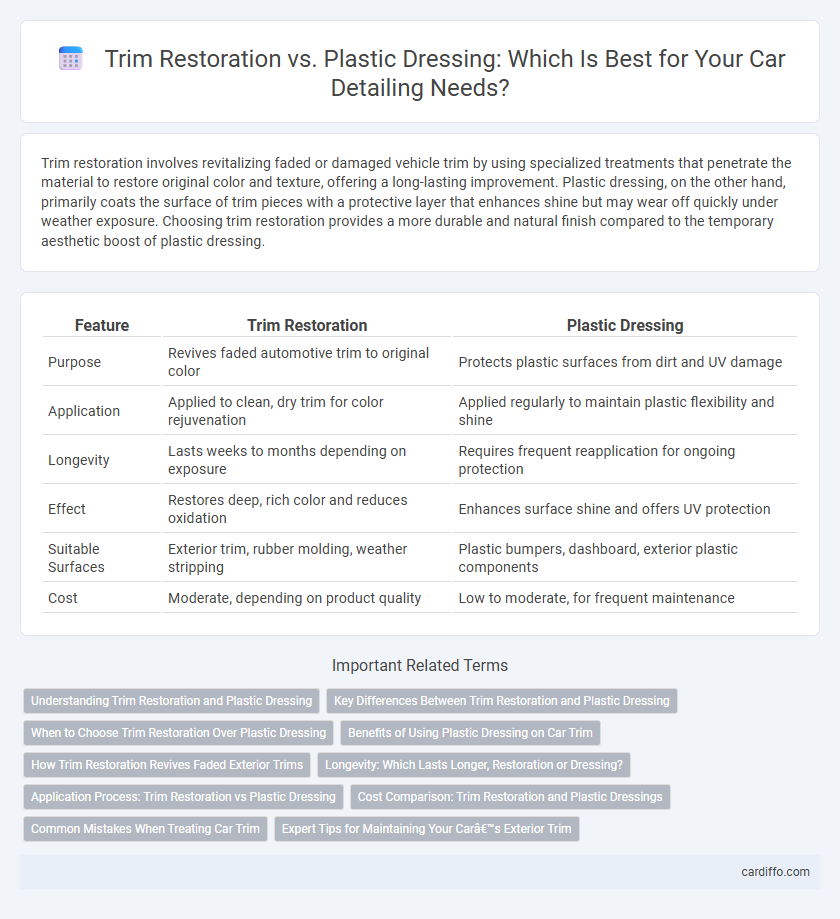Trim restoration involves revitalizing faded or damaged vehicle trim by using specialized treatments that penetrate the material to restore original color and texture, offering a long-lasting improvement. Plastic dressing, on the other hand, primarily coats the surface of trim pieces with a protective layer that enhances shine but may wear off quickly under weather exposure. Choosing trim restoration provides a more durable and natural finish compared to the temporary aesthetic boost of plastic dressing.
Table of Comparison
| Feature | Trim Restoration | Plastic Dressing |
|---|---|---|
| Purpose | Revives faded automotive trim to original color | Protects plastic surfaces from dirt and UV damage |
| Application | Applied to clean, dry trim for color rejuvenation | Applied regularly to maintain plastic flexibility and shine |
| Longevity | Lasts weeks to months depending on exposure | Requires frequent reapplication for ongoing protection |
| Effect | Restores deep, rich color and reduces oxidation | Enhances surface shine and offers UV protection |
| Suitable Surfaces | Exterior trim, rubber molding, weather stripping | Plastic bumpers, dashboard, exterior plastic components |
| Cost | Moderate, depending on product quality | Low to moderate, for frequent maintenance |
Understanding Trim Restoration and Plastic Dressing
Trim restoration involves refurbishing faded or oxidized vehicle trim by penetrating the surface to rejuvenate its original color and texture, offering long-lasting protection against UV damage. Plastic dressing primarily serves as a surface-level treatment that enhances shine and adds a temporary protective layer but does not restore the material's integrity or color depth. Understanding these differences helps in choosing the appropriate method for maintaining and improving automotive trim appearance and durability.
Key Differences Between Trim Restoration and Plastic Dressing
Trim restoration involves repairing and rejuvenating faded, oxidized, or damaged trim pieces by using specialized products that penetrate and restore the original material's color and texture. Plastic dressing, on the other hand, coats the surface with protective agents designed to enhance shine and provide a temporary layer of UV protection without repairing any damage. The key difference lies in trim restoration's focus on long-term repair and color revival versus plastic dressing's cosmetic enhancement and surface protection.
When to Choose Trim Restoration Over Plastic Dressing
Trim restoration is ideal when plastic trim shows deep oxidation, fading, or cracking that plastic dressing cannot mask or revert. Choosing trim restoration ensures color rejuvenation and protection by restoring the original pigment and texture, extending the durability beyond surface-level treatments. For long-term maintenance, especially on aged or severely weathered trim, restoration provides a more effective and lasting solution than plastic dressings.
Benefits of Using Plastic Dressing on Car Trim
Plastic dressing on car trim enhances UV protection, preventing fading and cracking while restoring a deep, rich finish. It repels dirt and water, making upkeep easier and extending the lifespan of the trim. Compared to trim restoration, plastic dressing offers quick application with immediate aesthetic improvement and long-lasting durability.
How Trim Restoration Revives Faded Exterior Trims
Trim restoration penetrates deep into the surface material, replenishing color and texture to faded exterior trims, unlike plastic dressing which merely coats the surface without addressing underlying wear. This process uses specialized polymers that bond with the trim, restoring flexibility and UV protection while eliminating chalky residue. By reviving the original appearance and durability of exterior trims, trim restoration extends the life and aesthetic appeal of automotive surfaces more effectively than traditional plastic dressing products.
Longevity: Which Lasts Longer, Restoration or Dressing?
Trim restoration offers significantly longer-lasting results compared to plastic dressing, as it chemically rejuvenates and revitalizes the surface rather than merely coating it. Plastic dressing typically provides a short-term shine that can fade within weeks due to UV exposure and weathering. Restoration treatments penetrate and protect trim for months, ensuring durability and sustained appearance.
Application Process: Trim Restoration vs Plastic Dressing
Trim restoration involves a multi-step application process including thorough cleaning, oxidation removal, and the use of specialized dyes or coatings to rejuvenate faded plastic or rubber surfaces. Plastic dressing typically requires a simpler application, often involving a wipe-on or spray-on product that conditions and adds shine without penetrating the material deeply. Trim restoration delivers longer-lasting and more transformative results by chemically restoring the original appearance, whereas plastic dressing mainly offers surface-level enhancement and protection.
Cost Comparison: Trim Restoration and Plastic Dressings
Trim restoration offers a cost-effective solution compared to plastic dressings by providing long-lasting results that reduce the need for frequent reapplications. While plastic dressings have a lower initial cost, they often require regular maintenance, increasing overall expenses over time. Investing in professional trim restoration can save money by enhancing durability and appearance with fewer treatments.
Common Mistakes When Treating Car Trim
Common mistakes when treating car trim include using plastic dressing products that cause buildup and attract dirt, leading to a greasy, unnatural finish. Trim restoration techniques offer a more durable and authentic rejuvenation by restoring the underlying material rather than merely coating it. Applying the wrong product or neglecting proper surface preparation can result in uneven color and accelerated degradation of the trim.
Expert Tips for Maintaining Your Car’s Exterior Trim
Regularly cleaning exterior trim with a non-abrasive cleaner prevents buildup that accelerates wear and fading, preserving the original finish. Using trim restoration products containing UV blockers restores color vibrancy and protects against sun damage more effectively than traditional plastic dressings. Applying restoration treatments every few months enhances durability, maintaining a showroom-quality appearance and extending the lifespan of your car's exterior trim.
Trim Restoration vs Plastic Dressing Infographic

 cardiffo.com
cardiffo.com